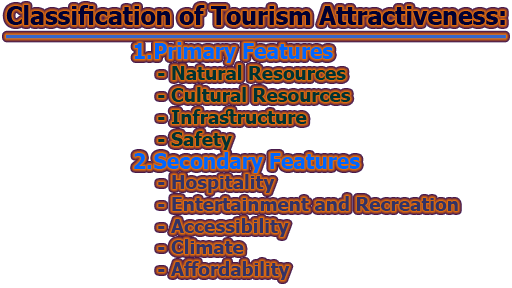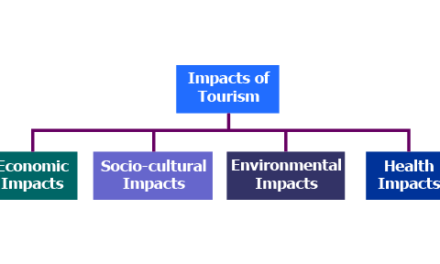Tourism attractiveness refers to the ability of a destination or a location to attract and retain visitors. It is determined by various factors, such as natural and cultural resources, infrastructure, safety, and services, among others. The more attractive a destination is, the more likely it is to draw visitors and generate tourism revenue. The concept of tourism attractiveness is essential for policymakers, tourism industry stakeholders, and destination managers to understand the strengths and weaknesses of a location and develop strategies to enhance its appeal to potential visitors. In the rest of this article, we will explore the classification of tourism attractiveness and the measurement of tourism attractiveness.
Classification of Tourism Attractiveness:
Tourism attractiveness displays the destination features that make it attractive for the tourists and depends on the availability of the resources and perceived values of these resources. Tourism attractiveness can be classified based on several primary and secondary features that determine a destination’s appeal to visitors.
Primary Features of Tourism Attractiveness:
– Natural Resources: Natural resources are a vital component of tourism attractiveness, and they include a location’s physical features such as mountains, forests, beaches, waterfalls, rivers, and lakes. These resources have the power to draw visitors to a destination and contribute to their overall experience. For example, the beautiful beaches in Hawaii and the lush greenery of the Amazon rainforest attract tourists from all over the world.
– Cultural Resources: Cultural resources are another essential primary feature of tourism attractiveness. They include historical and cultural landmarks, museums, art galleries, festivals, and other cultural events. These resources offer visitors an opportunity to learn about a destination’s unique history, traditions, and values. For example, the Great Wall of China and the Pyramids of Giza are some of the cultural resources that attract millions of tourists every year.
– Infrastructure: Infrastructure refers to the physical and organizational structures that support tourism, such as airports, roads, accommodations, restaurants, and other amenities. The quality of a destination’s infrastructure can significantly influence its attractiveness to visitors. For example, modern airports, high-quality hotels, and well-maintained roads can make a destination more attractive to visitors.
– Safety: Safety is another critical primary feature of tourism attractiveness. Tourists are more likely to visit destinations that are perceived as safe and secure. Safety can be ensured through measures such as proper law enforcement, emergency services, and adequate security measures. Tourists are more likely to visit destinations that are safe and secure.
Secondary Features of Tourism Attractiveness:
– Hospitality: Hospitality refers to the warmth and friendliness shown to visitors by the local population. It can significantly influence a visitor’s experience and their likelihood of returning to a destination. For example, destinations known for their hospitality, such as Thailand and India, often receive high numbers of repeat visitors.
– Entertainment and Recreation: Entertainment and recreation facilities can significantly enhance a destination’s attractiveness. They include theme parks, water parks, sports facilities, theaters, and nightlife. These facilities offer visitors a wide range of entertainment and leisure activities, which can contribute to their overall experience. For example, Disney World in Florida is a popular entertainment destination that attracts millions of tourists every year.
– Accessibility: Accessibility refers to how easy it is to travel to and within a destination. Destinations that are easily accessible by air, road, or rail are likely to be more attractive to visitors. For example, the popularity of cities like London and New York can be attributed, in part, to their excellent transport links and accessibility.
– Climate: Climate is another secondary feature of tourism attractiveness. A destination’s climate can significantly influence visitor numbers, particularly for outdoor activities. Destinations with favorable weather conditions are likely to attract more visitors. For example, the beaches in the Caribbean are popular because of their year-round warm climate.
– Affordability: Affordability refers to the cost of visiting a destination, including transport, accommodation, and other expenses. Destinations that offer good value for money are likely to attract more visitors. For example, budget-friendly destinations like Thailand and Bali attract visitors from around the world.
In summary, tourism attractiveness can be classified based on primary and secondary features that contribute to a destination’s appeal to visitors. Primary features include natural and cultural resources, infrastructure, and safety, while secondary features include hospitality, entertainment, accessibility, climate, and affordability. Understanding these features is essential for destination managers and policymakers to develop strategies that enhance their destinations’ appeal to potential visitors.
Measurement of Tourism Attractiveness:
Measuring tourism attractiveness is an essential aspect of destination management and marketing. It helps destination managers to identify the strengths and weaknesses of their destination and develop strategies to improve their attractiveness to visitors. Here, we will discuss the various methods used to measure tourism attractiveness.
- Visitor Arrivals and Expenditure: One of the most common methods of measuring tourism attractiveness is by analyzing visitor arrivals and expenditures. Visitor arrivals provide an indication of the number of tourists visiting a destination, while visitor expenditure provides insights into the amount of money spent by tourists at the destination. These two measures are often used to calculate the economic impact of tourism on a destination. By analyzing visitor arrivals and expenditures, destination managers can identify the peak and off-peak seasons, the primary markets, and the areas where more investment is required.
- Tourism Satellite Accounts: Tourism satellite accounts (TSAs) are another method used to measure tourism attractiveness. TSAs are a system of economic accounts that provide a detailed analysis of the contribution of tourism to a country’s economy. TSAs analyze data on visitor arrivals, expenditure, employment, and taxes to calculate the economic impact of tourism. They provide an overall picture of the tourism industry and can help destination managers to develop policies that maximize the benefits of tourism while minimizing the negative impacts.
- Tourism Quality Index: The Tourism Quality Index (TQI) is a method used to measure the quality of a destination’s tourism products and services. The TQI is a composite index that measures the quality of different aspects of the destination, including accommodation, food and beverage, transportation, and attractions. The TQI is based on a survey of tourists and local residents, and it provides insights into the perception of a destination’s quality. By analyzing the TQI, destination managers can identify the areas where improvement is required to enhance the destination’s attractiveness.
- Tourism Climate Index: The Tourism Climate Index (TCI) is a method used to measure the climate-related attractiveness of a destination. The TCI is based on a combination of climatic factors, including temperature, precipitation, and sunshine hours. The TCI provides an indication of the overall attractiveness of a destination’s climate for tourists. By analyzing the TCI, destination managers can identify the areas where climate-related improvements are required to enhance the destination’s attractiveness.
- Sustainable Tourism Indicator: Sustainable tourism indicators (STIs) are a method used to measure the sustainability of a destination’s tourism industry. STIs are based on a set of indicators that measure the economic, environmental, and social impacts of tourism on a destination. The STIs provide an overall picture of the sustainability of the tourism industry and can help destination managers to develop policies that promote sustainable tourism practices.
- Destination Competitiveness Index: The Destination Competitiveness Index (DCI) is a method used to measure a destination’s competitiveness. The DCI is based on a set of indicators that measure a destination’s performance in various areas, including natural and cultural resources, infrastructure, safety and security, and travel and tourism policy and enabling conditions. The DCI provides an overall picture of a destination’s competitiveness and can help destination managers to develop strategies to enhance their destination’s attractiveness.
In addition to the methods discussed above, there are other ways to measure tourism attractiveness that destination managers may find useful. Some of these include:
- Social Media Metrics: Social media platforms such as Facebook, Instagram, and Twitter are increasingly being used by tourists to share their experiences with others. Destination managers can use social media metrics to measure the online visibility and reputation of their destination. Metrics such as the number of followers, likes, shares, and comments can provide insights into the popularity of a destination. By analyzing social media metrics, destination managers can identify areas where their destination is doing well and areas where they need to improve.
- Repeat Visitors: The number of repeat visitors to a destination is another indicator of tourism attractiveness. Repeat visitors are those who have visited the destination more than once. A high percentage of repeat visitors indicates that the destination has a loyal fan base, and tourists are satisfied with their experience. Destination managers can use this information to develop strategies to retain existing visitors and attract new ones.
- Brand Recognition: Brand recognition is an essential aspect of destination marketing. The more recognizable a destination’s brand is, the more likely tourists are to visit. Destination managers can measure brand recognition by conducting surveys or analyzing online mentions of the destination. By analyzing brand recognition, destination managers can identify areas where they need to improve their marketing efforts.
- Visitor Satisfaction: Visitor satisfaction is a crucial measure of tourism attractiveness. Satisfied visitors are more likely to recommend the destination to others and return in the future. Destination managers can measure visitor satisfaction through surveys or by analyzing online reviews. By identifying the factors that contribute to visitor satisfaction, destination managers can develop strategies to enhance their destination’s attractiveness.
- Cultural and Natural Heritage: Cultural and natural heritage is an essential aspect of tourism attractiveness. Destinations with rich cultural and natural heritage are more likely to attract tourists interested in history, art, and nature. Destination managers can measure the cultural and natural heritage of their destination by conducting surveys or analyzing data on the number of heritage sites and protected areas.
Overall, measuring tourism attractiveness is a complex process that requires destination managers to analyze a range of indicators. While there is no single method that can provide a complete picture of tourism attractiveness, a combination of methods can provide valuable insights into the strengths and weaknesses of a destination. By understanding what makes their destination attractive to visitors, destination managers can develop strategies to enhance their destination’s appeal and compete in an increasingly crowded global tourism market.
References:
- Buhalis, D. (2000). Marketing the competitive destination of the future. Tourism Management, 21(1), 97-116.
- Fuchs, M., & Weiermair, K. (2003). Destination attractiveness based on a comparative analysis of tourists’ and locals’ perceptions: The case of the Tiroler Zugspitz Arena. Journal of Travel Research, 42(3), 333-340.
- Jafari, J., & Aaser, D. (1988). Tourism models: The sociocultural aspects. Tourism models and methodologies, 1-32.
- Leask, A., Fyall, A., & Garrod, B. (2012). Managing world heritage sites. Elsevier.
- Oppermann, M. (1996). Tourism destination loyalty. Journal of travel research, 35(4), 17-24.
- Pechlaner, H., & Raich, F. (2013). Competitiveness of tourism destinations: An empirical investigation. Journal of Travel Research, 52(1), 1-14.
- Pike, S. (2015). Tourism destination branding complexity. Journal of Destination Marketing & Management, 4(1), 1-2.
- Ritchie, J. R., & Crouch, G. I. (2003). The competitive destination: A sustainable tourism perspective. CABI.
- Sigala, M. (2004). Consumer behavior in travel and tourism. Elsevier.
- Smeral, E. (2003). Assessing tourism competitiveness: issues and cases. Journal of travel research, 42(4), 357-371.

Assistant Teacher at Zinzira Pir Mohammad Pilot School and College










